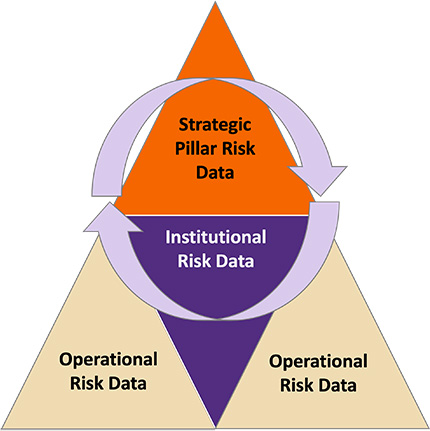Enterprise Risk Management (ERM)
What ERM Does
- Provide institutional and operational risk data to inform strategic planning and decision making.
- Provide a framework to facilitate the identification, assessment and reporting of institutional risk.
- Provide a framework to assist functional areas in identification and assessment of operational risks and a mechanism (tool) to track the operational risk data.
- Provide risk consulting and assessment services.
We strive to collaborate with risk focused groups across campus. We are all responsible for identifying and mitigating risks as part of our work at Clemson. To make sure we are successful in our mission and strategic goals, we will work together to manage risks and execute mitigations for continuous improvement as an institution.
Request OIE SupportERM Data Building Blocks

The diagram shows a triangle made up of 4 smaller triangles. The bottom two show operational risk data, the middle shows institutional risk data, and the top shows strategic pillar risk data. There is a continuous circle arrow touching all parts of the bigger triangle to show how all risk data is connected.
Clemson’s Approach
Clemson University defines enterprise risk management as a process-driven tool that enables identification, assessment, mitigation, and reporting of risks that may adversely impact Clemson Elevate.
It is the responsibility of the President to lead and cultivate a culture of risk awareness using the ERM process. The Board members, institutional leaders, faculty, and staff are responsible for identifying, assessing, mitigating, and reporting risks associated with any activity, function, or process within their relevant scope of responsibility and authority.
Risk is a part of regular business activities when appropriately identified and managed. However, in certain cases, there are types of risks that may not be acceptable, such as:
- Willful exposure of students, employees or others to hazardous environments or activities;
- Intentional violation of laws;
- Waste, fraud, and abuse; or,
- Unethical behavior.
Clemson’s approach to risk management is to minimize the effects of ethics/compliance/legal, financial, life/health safety, missions, operational, and reputational risks while accepting a reasonable degree of managed risk in pursuit of its mission and objectives. Clemson recognizes that risk varies according to the activity undertaken, that acceptance of risks is always subject to ensuring potential benefits, and risks are fully understood and that prudent measures to mitigate risk are established.
Learn More about Risk
Institutional Risk
How we overcome obstacles to meeting our institutional goals.
Operational Risk
How we handle uncertainties the University faces in the course of daily operations.
Customized Services
We are here to drive Clemson's success by offering tailored risk management and business continuity services. Our team will collaborate closely with you at every step to ensure your risks are appropriately documented and your business continuity plan is sufficient for your needs. Our approach is customized to the university's unique needs, is flexible to accommodate the institution's varying units, and is designed to ensure the university’s success.
Contact us at cuerm@clemson.edu to discuss how we can help you identify, assess, mitigate/manage and report on your unique risks, or develop, update, or refresh your business continuity plan.


